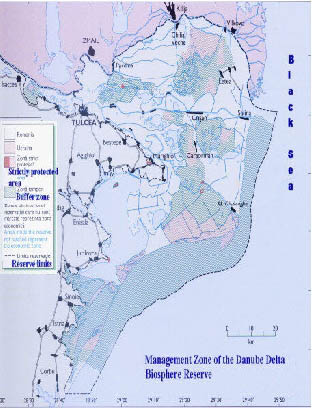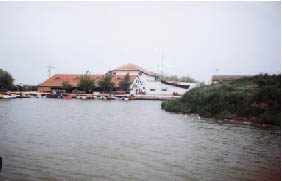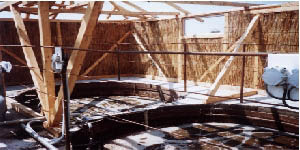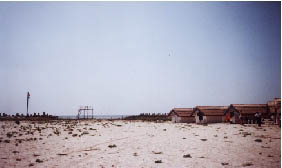|
Description
The Danube Delta is one of Europe's largest wetlands.
About twenty percent of the Danube Delta is situated
in Ukraine and eighty percent in Romania. It consists
of 150.000 ha of alluvial islands, marshes, tributaries,
canals and lakes. With an internationally recognized
importance for biodiversity (there are three RAMSAR
wetlands in the Ukrainian part alone and one in Romania).
The area supports more than 70 fish species, 225 bird
species, 500 plant species and 22 mammal species. Also
including several endangered birds, like the Dalmatian
pelican, Pygmy cormorant and White-tailed Eagle. Dynamic
natural processes give this area its unique character.
More than 46,000 ha of the delta was included in the
Danube Biosphere Reserve in August 1998. The abundance
of wildlife, especially birds, makes the Danube Delta
a potential top destination for eco-tourism.
|

Who, Where and When
Gura Portitei is located in the southern part of the
Danube Delta Biosphere Reserve on a sand spit bar between
the lagoon system Razelm Sinoe and the Black Sea. Recently,
a small touristic resort has been developed at Gura
Portitei with a minihotel, pension, floating boats accommodation,
several wooden bungalows and a camp site.
Gura Portita is well known for the beauty and the wildness
of its landscapes. Being situated on a natural sand
split offers the possibility of a holiday into the biosphere's
reservation and the littoral. There are beaches, which
are mostly visited by young people in particular those
who love nature and fishing. Varied, plentiful bird
life and varied fauna can be found in the vicinity of
these beaches which are located in the Danube Delta
Biosphere Reserve. Access to Gura Portitei is possible
only by boat from Jurilovca village, situated on the
other side of the lake. Besides tourists that spend
their holiday in Gura Portita, the beaches are visited
daily by tourists.

Gura Portitei beach is a beach which is situated at
a small resort. It provides toilets, meals, drinks,
ice cream and there are lifeguards at busy weekends.
The largest amount of tourists prefer to visit a beach
with some facilities. While people also want to enjoy
the environment of the Danube Delta and the sea at the
same time. Access to this resort is only possible by
boats which depart from Jurilovca (a small village situated
on the western shore of Razim Lake)
This beach is well managed by a private company which
developed beach facilities such as: toilets- (more then
three, all very clean), showers (with hot water / very
clean), restaurants (meal and drink offers), presence
of lifeguard, rent of boats and pedal boats.

Beach design and comfort are highly appreciated by
tourists at Portita beach due to the wild landscape
and environment. A small sewage treatment plant has
been installed, as well as potable water treatment.
Showers with hot water, toilets and wooden bungalows
together with a small pension and mini hotel exist.
Taking into consideration that this area is protected
for conservation, tourism development is not allowed
everywhere. The Danube Delta Biosphere Reserve Administration
which is managing the area, including the beaches, prevents
the economical agents from developing significant tourist
activities. This is the reason for the low number of
tourist in this area. They enjoy the beaches as they
are quiet and not well developed. At Portita, an office
of DDBRA for ecological inspection of the area is the
main local point for survey and observation.
|
|
Risk
Coastal erosion tendency has been noticed on the Portita
shore since 1980. This phenomenon appeared as a consequence
of the hydrotechnical works carried out northwards,
in the Sulina area. Extension seawards of the jetties
from Sulina branch mouth to prevent navigation channel
silting changed the marine currents direction seaward
and consequently Portita beach received diminished sand
quantities.
Additionally, hydro-meteorological conditions were
not favorable and so erosion of the beach became stronger.
At that time, decision makers considered it useful to
build hard coastal protection structures to prevent
the creation of a sand bar at Portita. The most fragile
area which separates Razim lagoon by the sea.
Coastal protection projects for the Gura Portitei have
been developed to ensure coastal stability for the next
fifty years. For the moment, the erosion phenomenon
in this area has been halted, but further south, where
no coastal protection exists, the erosion process became
stronger.
|
|
Conclusions
No other development projects or actions are planned
in this area due to its specific aim concerning nature
conservation. During the last years, a remarkable investment
has been made following the sustainable tourism principles.
A the new touristic site with an accommodation capacity
230 places which is made up out of 72 places for bungalows,
158 places in wooden huts and three stars hotel has
been built. Suitable areas have been arranged for tent
settlements. The touristic development plan includes
all the required facilities for ecological and sustainable
tourism in this natural reserve; Sewage,freshwater networks,
a sewage treatment station and freashwater treatment
have been installed recently. Toilets and warm water
showers, an observation tower for lifeguards and reed
umbrellas for tourist have been placed on the beach
.
For the short term, no threats exist which directly
affect the touristic infrastructure and fishery activities.
On the other hand, there have been conflicts between
users that are controlled by the DDBR Administration.
However, beach protection and preservation needs more
attention of local and governmental authorities in this
particular area and pilot projects are necessary to
avoid the potential risks that could appear in the future.
The population around this area is mainly interested
in preservation and conservation of this area. At the
same time, the development of eco-tourism creates new
jobs for the locals and this represents an alternative
income resource for them besides the ones from fisheries
and agriculture.
|

|